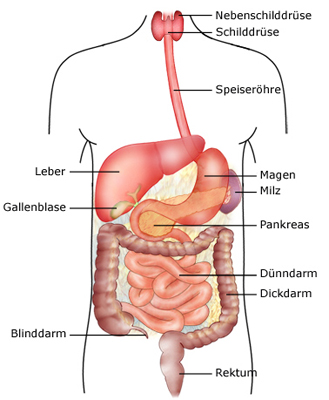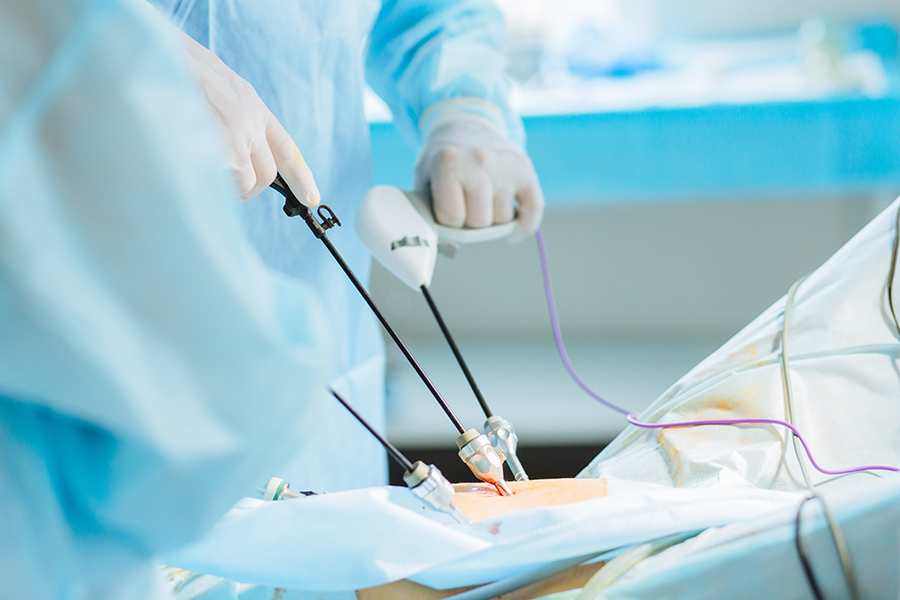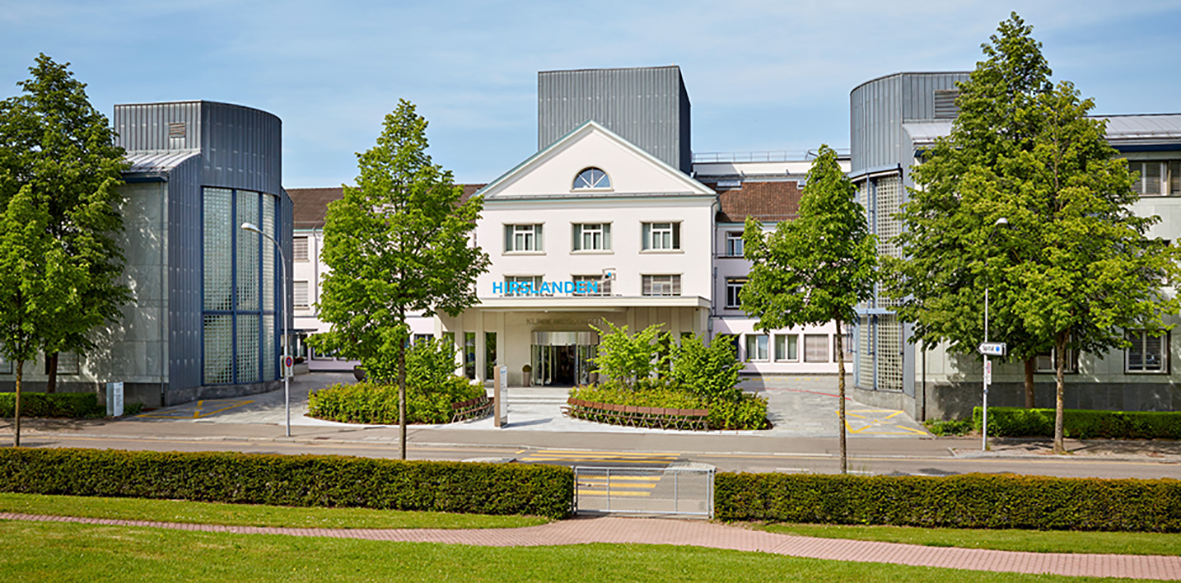Patient information
Welcome
Dear patients
Dear relatives and interested parties in general
When you or someone else is diagnosed with a medical condition, it is natural that many questions will want to be answered. As a visceral surgeon, answering such questions, but also explaining and presenting complex facts from the medical field, is a large part of my daily work. During my many and sometimes very intensive educational discussions with patients about upcoming procedures, I also became increasingly aware of how strong the patients’ need for information really is and how important it therefore is to meet this need.
The following pages will therefore provide you with answers to the most important patient questions as well as examination and treatment options for selected clinical pictures. We have tried to make our disease descriptions as detailed as possible, yet they are not always sufficient for non-medical professionals to understand everything at once. The personal conversation with your treating physician can and must never be replaced by a patient brochure or by searching the Internet.
I am always very happy to answer any questions or provide a second opinion.
Your Hans U. Baer
Abdominal diseases
The personal conversation
Have you just learned that you have abdominal disease? Or does such a disease affect a family member, a close friend or acquaintance? Are you afraid? Are you unsure and do not know what all can be done at present or how to actually proceed?
Often in today’s information society, there is a tendency to want to solve questions via the Internet first. The World Wide Web is capable of reproducing a great deal of information, but in many cases this information cannot always be properly grasped and understood. Moreover, this information usually concerns only rational objectivity; the subjective feeling, which must be given great consideration especially in the case of illness, is often neglected. Patients as well as their relatives need not only the professional competence of a physician, they also need his human advice, his psychological guidance and his spiritual accompaniment.
Dear web user, if you or a relative has been diagnosed with an abdominal disease that is bothering you a lot, try not to try to solve your questions just through the Internet. Seek personal discussion with a physician who specializes in this area and who may accompany such people day after day. We would like to offer you this help.
We are at your disposal during our office hours.
Visceral Surgery
Abdominal or abdominal surgery
Visceral surgery – also known as abdominal surgery – is essentially concerned with the surgical treatment of abdominal organs, specifically organs of the gastrointestinal tract. Consequently, the core area of visceral surgery includes the detection, clarification, consultation and surgical treatment of diseases of the esophagus, pancreas, stomach, small, large and rectum, liver, bile and spleen. Furthermore, the surgical treatment of the thyroid gland, the parathyroid gland and the inguinal hernia (hernia) is also attributed to this field. Finally, visceral surgical treatment always requires consideration of gastroenterologic, endocrinologic, and oncologic criteria.


- Hepatobiliary surgery (liver, gallbladder, bile ducts)
- Pancreatic surgery (pancreas)
- Upper gastrointestinal surgery (organs of the upper half of the abdomen)
- Lower gastrointestinal surgery (organs of the lower half of the abdomen)
- Colorectal surgery (colon, rectum, proctology)
- Endocrine surgery (thyroid glands, parathyroid glands)
- Transplant surgery (organ transplants)
- Oncological surgery (tumor resections)
Abdominal diseases
Abdominal diseases and their surgical treatment methods
Abdominal diseases are among the most frequently diagnosed human diseases in modern times. Abdominal diseases are diseases of the organs and organic structure in the abdominal cavity (abdomen), which manifest themselves in a wide variety of symptoms. Since these symptoms can be multifaceted and complex, the diagnosis is not always easy.

What are the symptoms?
In acute abdominal diseases, sudden severe colicky abdominal pain is one of the most common symptoms and may be accompanied by other complaints such as nausea, vomiting, diarrhea, constipation, fever, night sweats or pallor. Such symptoms require medical clarification as soon as possible.
How is the patient examined?
The responsible general practitioner or specialist must first ask the patient about his or her entire medical history (anamnesis) and then examine him or her thoroughly (status). In this context, checks of pulse, blood pressure, respiration and body temperature are also of great importance and can give indications about the type, intensity and extent of the disease.
Finally, ultrasound and X-ray imaging, laparoscopy, or extensive blood tests may be required to definitively and unequivocally determine disease.
Treatment options
For diagnosed abdominal diseases
There are several options for the treatment of diagnosed abdominal diseases. On the one hand, there are special medications that may already be sufficient for adequate treatment. On the other hand, there is surgical treatment, whereby a distinction must be made between laparoscopic (keyhole) and open surgery (laparotomy).
Treatment of such pancreatic diseases is often associated with prolonged conservative therapy and sometimes ends with surgical intervention. There are a variety of surgical methods that are capable of removing the glandular organ partially or completely, although today organ-preserving methods are generally preferred. Read more >

Pancreatic Aid
Help for pancreas sufferers
Cooperation with the Swiss Self-Help Group of Pancreatic Diseases (SSP) and the Working Group of Pancreatectomists e.V. (AdP)
More and more people today suffer from pancreatic disease, which can be diagnosed by currently available diagnostic means such as ultrasound, computed tomography, magnetic resonance imaging or fine needle aspiration with biopsy. The most common diseases include, for example, chronic or acute inflammation (pancreatitis), pancreatic tumors (pancreatic carcinomas) and pancreatic cysts.
Treatment of such pancreatic diseases is often associated with prolonged conservative therapy and sometimes ends with surgical intervention. There are a variety of surgical methods that are capable of removing the glandular organ partially or completely, although today organ-preserving methods are generally preferred.
Operation methods
1. resection procedures are mainly distinguished between the following four methods:
Read more >
a) Total pancreatectomy
Total pancreatectomy involves removing not only the entire pancreas, but also the duodenum, gallbladder, often the spleen, and sometimes part of the stomach.
b) Partial duodenopancreatectomy
Partial duodenopancreatectomy is also referred to as Whipple surgery, in which the head of the pancreas, duodenum, gallbladder, and part of the stomach are resected. However, we generally prefer pylorus-preserving pancreatectomy, in which the stomach is preserved.
c) Duodenum-preserving pancreatic head resection.
In duodenum-preserving pancreatic head resection, only the pancreatic head tissue is removed and then a loop of small bowel is sutured to the site of the excised head to drain the pancreatic juice. The duodenum remains intact.
d) pancreatic left resection
In pancreatic left resection, the tail of the pancreas (with or without the body) is resected rather than the head of the pancreas. In most cases, the spleen is also removed. The head of the pancreas is preserved.
2. besides the resecting operations, there are also the two draining procedures: Read more >
a) Latero-lateral pancreaticojejunostomy according to Pustow
In the latero-lateral pancreaticojejunostomy according to Pustow, a congested pancreatic duct is diverted into a loop of the small intestine. This can prevent the pain-causing pressure in the congested pancreatic duct, and the pain can be controlled. This operation often also requires a resection of tissue from the head of the pancreas, which prevents drainage of the pancreatic duct.
b) cysto-jejunostomy
In cystojejunostomy, large, chronic pancreatic pseudocysts are drained into the small bowel. Insulinomas, which are benign growths in the pancreas, can often be excised from healthy tissue without removing unaffected tissue.
Note
All operations are very difficult interventions. They should only be performed by highly experienced pancreatic surgeons. For the patients concerned, such operations are potentially associated with severe pain, which can, however, be treated today with a variety of pain therapies. Nevertheless, such major operations always bring health problems after the intervention, such as digestive disorders, diabetes mellitus or general physical and sometimes psychological problems. Patients usually have to live with medical and/or oncological therapies, which is not always easy to cope with from a psychological point of view.
Swiss Self-Help Group for Pancreatic Diseases (SSP)
In cooperation with the Swiss self-help group for pancreatic diseases (SSP), we try to provide all pancreatic patients with a complete consultation and treatment service, which the affected patients can use before, during and after surgical therapy. Together with specialists, psychologists and caregivers, we try to offer the best possible and caring environment.

Working Group of Pancreatectomists in Germany
Information on the Working Group of Pancreatectomized Persons in Germany can be found at:
ADP e.V. | Working group of pancreatectomists | Bonn (bauchspeicheldruese-pankreas-selbsthilfe.de)

Treatment principles
By Prof. Dr. med. Hans U. Baer
The four principles of treatment are the concentrate of my life and professional experience. As guiding principles and instructions for action, they show his understanding of people who entrust themselves to him as patients.
I thank my teachers Markus W. Büchler, full professor of surgery, Heidelberg, and Leslie H. Blumgart, Memorial Sloan-Kettering Cancer Center, New York, and, on behalf of all patients, Jacky Donatz for his statement.
Prof. Dr. med. Hans U. Baer

My patient and I, his doctor.
Principle 1: Human understanding for the patients
Read more >“As a master chef, I set the highest standards: for my cuisine, for my menus, for my wines. My guest is at the center of my cooking. I place the same high demands on my surgeon: on knowledge, on skill, but above all on a deep personal understanding of me and my illness. He has fulfilled my expectations. I would not put myself in any other hands. He has changed my life for the better.”
Jacky Donatz, Master Chef (†)
formerly Restaurant Sonnenberg, Zurich
Surgery is a medical art that uses knowledge from all fields of knowledge and which has been proven to be useful in the treatment of sick people and to contribute to their recovery. The foundations of academic surgery are exact scientific results and findings from all the work of clinical and basic research.
The best results for their patients are achieved by surgeons who actively participate in this research and who use their own questions that arise from their daily dealings with patients to set up working hypotheses and check them according to scientific criteria. These academically active surgeons have learned to critically appreciate their own findings, as well as the published results of the medical-surgical literature, and to classify them in the context of the constant development of science.
Academic surgery develops its full impact when outcomes and clinical experience with patients can be critically debated and questioned in an open atmosphere. This happens most sustainably in daily interactions with students, surgeons and physicians in training and at special medical congresses and continuing education events, in lectures and discussions. Critical questioning, questioning, creative thinking on a solid scientific basis provide impetus to further improve and develop the field of surgery. With the more precise and cost-effective procedure, the surgical interventions should provide great benefit to patients in the gentlest way possible. Without scientific knowledge, successful surgical activity is not possible.
Principle 2: Proven and up-to-date scientific knowledge
Read more >“The successes of modern academic surgery are based on basic research, especially findings in molecular biology. Complex, major abdominal surgery should therefore be performed by surgeons who also conduct research.”
Prof. Markus W. Büchler
Professor of Surgery, Heidelberg
Surgery is a medical art that uses knowledge from all fields of knowledge and which has been proven to be useful in the treatment of sick people and to contribute to their recovery. The foundations of academic surgery are exact scientific results and findings from all the work of clinical and basic research.
The best results for their patients are achieved by surgeons who actively participate in this research and establish working hypotheses with their own questions arising from their daily interaction with patients and test them according to scientific criteria. These academically active surgeons have learned to critically evaluate their own findings, as well as the published results of the medical-surgical literature, and to classify them in the context of the constant development of science.
Academic surgery develops its full impact when outcomes and clinical experience with patients can be critically debated and questioned in an open atmosphere. This happens most sustainably in daily interactions with students, surgeons and physicians in training and at special medical congresses and continuing education events, in lectures and discussions. Critical questioning, questioning, creative thinking on a solid scientific basis provide impetus to further improve and develop the field of surgery. With the more precise and cost-effective procedure, the surgical interventions should provide great benefit to patients in the gentlest way possible. Without scientific knowledge, successful surgical activity is not possible.
Principle 3: Outstanding technical skills
Read more >“Technique is only important until it is perfect – and it has to be perfect. Once perfect, other factors are decisive in achieving surgical success.”
Leslie H. Blumgart,
Professor of Surgery
Memorial Sloan-Kettering Cancer Center, New York
Surgery is first and always a craft. The hands are the surgeon’s most important instrument. Only through them he can work precisely, accurately, carefully and gently and achieve for patients good results, fast healing of operations, without complications. All manual skills must be learned first, even by the very talented, as with any other craft. Like a musician, music is only beautiful, light and elegant after long years of learning, developing one’s technique and practicing constantly.
The surgical technique can also be compared to the art of painting. A blank sheet is covered by many strokes, broad, narrow, long and short until the eye can see an image and the soul can recognize it. Surgical technique cannot be perfected until the surgeon has performed a large number of different operations in many fields and he personally knows most of the variations of these operations intimately. The organs, their interaction, their position as well as the gentlest approaches are only recognized in context when many different operations are experienced and worked out until all the details come together to form a whole.
Technical virtuosity is a prerequisite for surgical practice. But it is not an end in itself. The technology must be perfect. But if it is perfect, it becomes secondary to all the other factors that determine the success of an operation. If the technique is right, the announcement of the operation, the understanding of the capacity of the patient’s body, what it may endure physically and mentally, become crucial. There is nothing worse in surgery than soulless technicians. Often we surgeons have to toil, stare absolutely focused on a small area, stand in the same place for hours, and work with iron discipline, without slackening.
Technical perfection is the prerequisite for the title of “good surgeon”. It is indispensably necessary and must be practiced daily. In major surgery, which can be very difficult, the surgical art is often to leave open back roads where surgery can be aborted without immediate harm to the patient. Or the expert understands how to find different ways of circumventing difficulties, bypassing surgical problems in places where bleeding can occur, for example, and ultimately achieving the goal anyway.
As in any art, there are very different artists, and not every surgeon, if he is completely honest with himself, can claim that he has been able to reach every higher level. Even among surgeons there are virtuoso masters with elegant play and technical subtleties. In abdominal surgery, unfortunately, this is often only recognized by the assistants present. For outsiders who only see the superficial skin wound, it is practically impossible to appreciate the technical skills of a surgeon. Continuous development, comparison with other operating colleagues, visits to other internationally recognized centers, allow the individual surgeon to see for himself where he stands and where he needs further technical improvement.
If the technique is perfect, and it must be, the only thing that ultimately determines the safe results of surgery is the correct indication.
Principle 4: Correct choice of indication
Read more >“The personally important principles for a surgical activity and the performance of surgical procedures that are valid for me and my staff are: Human understanding of patients, proven and up-to-date scientific knowledge, outstanding technical skills, correct choice of indication (surgery indication).”
Prof. Dr. med. Hans U. Baer
FMH specialist in surgery, esp. Visceral Surgery
Baermed – Practice for Visceral Surgery Zurich
The greatest art in the surgical subjects of medicine is the ability to find the right type of surgical procedure for each patient. This used to be relatively easy with a limited number of procedures. Today, however, even for relatively simple procedures, such as for an inguinal hernia, there is no longer just one procedure, but a whole range of different methods. Each has its advantages and disadvantages, none is one hundred percent safe even when perfectly executed. There are open, closed, minimally invasive, with or without foreign material insertion procedures. The surgeon must know them all. He will feel quite confident in some procedures and will be able to recommend the procedures to patients. Others, however, he carries out himself less readily or with less success.
After the exact disease is identified, often after long and stressful examinations, the question for the abdominal surgeon is whether a patient is operable. That is, whether the patient can be expected to undergo surgery at all on the basis of the physical findings. The second point to assess concerns resectability. This is the technical way to operate on a finding. Clarification of operability is done for heart, lungs, kidneys, liver functions and more. These examinations are performed by internal medicine specialists. Preoperative assessment of whether a finding can be technically removed often must be judged on the basis of imaging studies.
From two-dimensional images, the surgeon must identify the exact location of organs and organ diseases in the body and decide whether to perform the operation. When can which patient be expected to undergo which intervention? As a matter of principle, we look for the smallest, least invasive procedure that is associated with the lowest risk in terms of the patient’s physical performance. Factors such as previous illness, organ performance limitations, and sometimes biological age, and often the patient’s attitude, must be considered and carefully weighed and evaluated.
The surgeon’s own skill, experience and willingness to take risks as well as his sense of responsibility, his ability all by himself to make often vital decisions and to carry them, also determine the indication for an operation. Time pressure, often also inaccurate or only insufficient findings and contradictory clarification results, burden the surgeon. All too often, he has to decide in these situations without ever being able to be completely sure. Therefore, the indication site, especially surgically, is also an art that can only be learned with total commitment and years of work.
